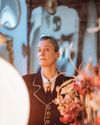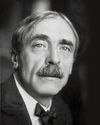
On August 7, 1829, Felix Mendelssohn took a steamer from the Scottish mainland to the grandly rugged island of Mull, in the Inner Hebrides. Later that day, the composer wrote to his sister Fanny, "To illustrate how strangely the Hebrides affected me, the following just occurred to me there." He then set down twenty-one bars of music in B minor, with indications for orchestration: a downward eddying theme in the violas and cellos, silvery chords in the violins and winds. From that sketch emerged the "Hebrides" Overture, which is sometimes called "Fingal's Cave," although Mendelssohn didn't see that landmark until the next day.
I listened to "The Hebrides" countless times when I was a kid, its surging lines and sea-spray climaxes conjuring Turneresque pictures in my mind. When, in September, I visited Mull for the first time, the island lived up to its musical archetype, looming out of the mist like a mass of gray shrouds thrown onto the ocean. Appropriately, I was on my way to see a chamber music series called Mendelssohn on Mull, which has been running since 1988. It was founded by the London-born violinist Leonard Friedman, who wished to lead master classes in an atmosphere free of urban pressures. In recent years, Mendelssohn on Mull has had a quartet in residence, which gives concerts while providing guidance to younger musicians. This year, the Maxwell Quartet, a mostly Scottish ensemble, took over from the Doric Quartet.
It's not a Mendelssohn festival.
Only three of the composer's pieces appeared in the programs, amid works by Haydn, Mozart, Beethoven, Dvořák, and Glazunov. Listeners were left to decide for themselves how this largely Central European repertory related to the edge-of-the-world terrain around them. Certainly, the chamber-music classics are suited to the intimacy of the island's venues-small churches and village halls-and to the informal conviviality of the audience.
この記事は The New Yorker の October 07, 2024 版に掲載されています。
7 日間の Magzter GOLD 無料トライアルを開始して、何千もの厳選されたプレミアム ストーリー、9,000 以上の雑誌や新聞にアクセスしてください。
すでに購読者です ? サインイン
この記事は The New Yorker の October 07, 2024 版に掲載されています。
7 日間の Magzter GOLD 無料トライアルを開始して、何千もの厳選されたプレミアム ストーリー、9,000 以上の雑誌や新聞にアクセスしてください。
すでに購読者です? サインイン

HOLIDAY PUNCH
\"Cult of Love\" on. Broadway and \"No President\" at the Skirball.

THE ARCHIVIST
Belle da Costa Greene's hidden story.

OCCUPY PARADISE
How radical was John Milton?

CHAOS THEORY
What professional organizers know about our lives.

UP FROM URKEL
\"Family Matters\" and Jaleel White's legacy.

OUTSIDE MAN
How Brady Corbet turned artistic frustration into an American epic.

STIRRING STUFF
A secret history of risotto.

NOTE TO SELVES
The Sonoran Desert, which covers much of the southwestern United States, is a vast expanse of arid earth where cartoonish entities-roadrunners, tumbleweeds, telephone-pole-tall succulents make occasional appearances.

THE ORCHESTRA IS THE STAR
The Berlin Philharmonic doesn't need a domineering maestro.

HEAD CASE
Paul Valéry's ascetic modernism.